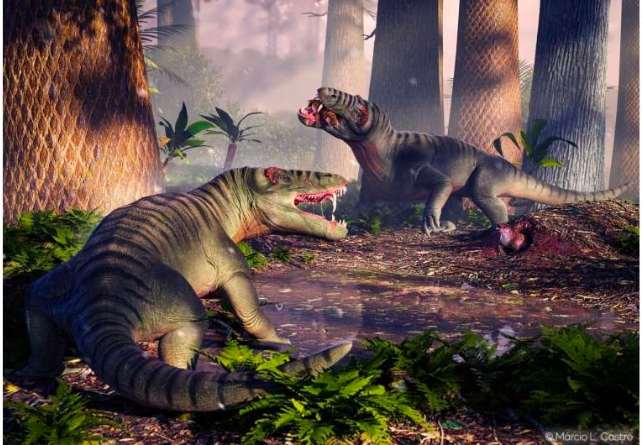
Dinosaurs have a reputation for being the most terrifying prehistoric predators, but a newly discovered skull sheds light on a fearsome beast that dominated 40 million years before the first ‘terrible lizards’ walked the Earth.
The 265-million-year-old fossil found in Brazil reveals the largest meat eater of its time, one that prowled the jungles searching for unlucky critters to chomp on.
“This animal was a gnarly-looking beast, and it must have evoked sheer dread in anything that crossed its path,” says Harvard University paleontologist Stephanie Pierce.
An almost-complete fossilized skull of Pampaphoneus biccai measuring almost 36 cm (14.2 inches) was discovered along with skeletal bones near São Gabriel in Southern Brazil.

Pampaphoneus fits into the early therapsid clade dinocephalia, a major group of generally large and frightening terrestrial animals that thrived before T. rex and pals. Dinocephalians were not all carnivores, but Pampaphoneus sure was.
“The animal had large, sharp canine teeth adapted for capturing prey,” says Felipe Pinheiro, a paleontologist from the Federal University of Pampa (UNIPAMPA) in Brazil.
“Its dentition and cranial architecture suggest that its bite was strong enough to chew bones, much like modern-day hyenas.”
Pampaphoneus lived at the end of the Permian, just before a mass extinction event – the largest ever – wiped out 86 percent of all animal species on Earth.
“The fossil was found in middle Permian rocks, in an area where bones are not so common, but always hold pleasant surprises,” says first author Mateus A. Costa Santos, a paleontologist at UNIPAMPA.
Fossils of other dinocephalians have previously been found in Russia and South Africa, but Pampaphoneus biccai is the only known species in Brazil, and the team says this well preserved fossil “reveals new characters previously unknown for the species,” since a smaller skull was found in 2008.
“Finding a new Pampaphoneus skull after so long was extremely important for increasing our knowledge about the animal,” says Santos, “which was previously difficult to differentiate from its Russian relatives.”

Pampaphoneus was certainly no pushover. These animals were a formidable sight at a towering 3 meters (10 feet) and estimated maximum weight of a jaw-dropping 400 kilograms (882 pounds).
In the last decade, the same region has provided evidence of Pampaphoneus‘s possible prey in the tiny reptile Rastodon and the enormous amphibian Konzhukovia. The sheer size of Pampaphoneus makes both creatures look like snacks.
“Pampaphoneus played the same ecological role as modern big cats,” Pinheiro says. “It was the largest terrestrial predator we know of from the Permian in South America.”
It wasn’t just its size that made Pampaphoneus stand out. Their skulls were thickly built, like many dinocephalians, earning the clade its fitting name, which translates to “terrible head” in Greek.

The new information revealed by this skull’s analysis leads the researchers to believe a currently unidentified jawbone is from an even larger, badder version of Pampaphoneus biccai. The team says more fossils are needed to confirm the hypothesis, but it could mean the terrible head they just studied is not even from an adult.
“Its discovery is key to providing a glimpse into the community structure of terrestrial ecosystems just prior to the biggest mass extinction of all time,” Pierce says. “A spectacular find that demonstrates the global importance of Brazil’s fossil record.”